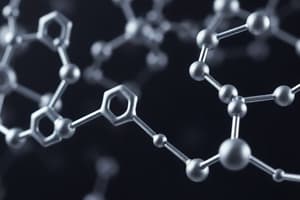Podcast
Questions and Answers
Explain the significance of the peptide bond in protein structure.
Explain the significance of the peptide bond in protein structure.
The peptide bond links amino acids together, forming polypeptide chains which are essential for the primary structure of proteins.
What are the key components of an amino acid and how do they influence protein function?
What are the key components of an amino acid and how do they influence protein function?
An amino acid consists of a central carbon, an amino group, a carboxyl group, a hydrogen atom, and a variable R group; the R group determines the chemical properties of the amino acid, influencing protein interactions and function.
Discuss the role of ribosomes in protein synthesis.
Discuss the role of ribosomes in protein synthesis.
Ribosomes are the cellular machinery that synthesizes proteins by linking amino acids in the order specified by mRNA during translation.
Describe how the structure of proteins can vary and the implications of this variation.
Describe how the structure of proteins can vary and the implications of this variation.
Identify the primary elements that compose proteins and their significance.
Identify the primary elements that compose proteins and their significance.
Flashcards are hidden until you start studying
Study Notes
Overview of Proteins
- Proteins constitute around 55% of the dry weight of cells and serve as essential structural and functional components.
- Found in all cell types, proteins facilitate a wide range of cellular functions.
- Ribosomes are the cellular machinery responsible for protein synthesis.
Chemical Composition of Proteins
- Proteins are primarily composed of carbon (C), hydrogen (H), oxygen (O), nitrogen (N), and can also include phosphorus (P), sulfur (S), and iron (Fe).
- Chemically, proteins are polypeptide chains, classified as polymers made up of amino acids.
Amino Acids
- Amino acids are the fundamental building blocks of proteins, with approximately 20-25 different types commonly occurring.
- Each amino acid features a central atom known as the alpha carbon.
- Attached to the alpha carbon are four distinctive groups:
- A hydrogen atom (-H)
- An amino group (-NH2)
- A carboxyl group (-COOH)
- An alkyl group labeled as -R
- The varying -R groups in amino acids distinguish their unique chemical properties.
Structure of Proteins
- Proteins can consist of a single polypeptide or multiple polypeptides, exhibiting diversity in their amino acid sequences and chain arrangements.
- Peptide bonds link individual amino acids together to form polypeptide chains.
- A typical amino acid structure includes:
- H - hydrogen atom
- α - central carbon atom
- R - alkyl group
- NH - amino group
- COOH - carboxyl group
Studying That Suits You
Use AI to generate personalized quizzes and flashcards to suit your learning preferences.




